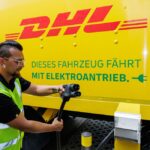Phil Danner, Vice President, Global Product Development, Intermec
World Mail Review, November 2008
About Intermec
Intermec develops, manufactures, and integrates technologies that identify, track, and manage supply chain assets—including numerous postal industry-focused solutions. For over forty years Intermec has worked alongside our postal and express parcel clients to improve the productivity, quality, and responsiveness of their business operations. Our customers include both national postal operators and parcel carriers on a global basis.Intermec understands the postal, express parcel, and home delivery marketplaces both in terms of industry requirements and mobility considerations. Our experience and shared investment with these clients allows them to improve across their core areas of operation, from item labelling, outward sortation, distribution, inward sortation, delivery, re-delivery, and proof of receipt. For more information about Intermec, visit www.intermec.com
The postal industry continues to face a highly competitive future as the volume of electronic communications grows even more predominant, translating to declining quantities of physical mail – and decreasing revenues. At the same time, postal operators are being hit hard by rising costs, which are further eroding profits, most recently in the form of higher fuel expenses. In order to be successful in such challenging times, industry leaders must find ways to both increase revenue and reduce costs. In particular, operators are actively searching out new revenue streams in order to increase profitability. In tandem, they must also reduce expenses by lowering fuel costs, increasing operational efficiencies – including the “Visibility and Control” of their operations – and also by eliminating errors. In order to meet these goals, the postal industry is increasingly looking at technological solutions.
New Revenue-Generating Services
One area which postal operators are turning to in order to generate revenue is the provision of add-on services such as parcel tracking-and-tracing. Shippers increasingly want to be able to track their items throughout each stage of the delivery process from collection to delivery. By providing such additional services, postal delivery companies are able to charge for this added visibility.
The use of technology to track both letters and parcels also means that postal operators can frequently update their customers via email or other means regarding the approximate delivery time of an item. Traditionally, customers who were expecting a delivery were given an 8-hour delivery window and often had to wait at home all day for the item to arrive. Now, however, it is possible for operators to communicate to customers a much more precise estimated arrival time for the delivery. Customers have clearly indicated a willingness to pay an additional charge for such a service given the tremendous time savings which this affords them.
Another customer service aspect that postal operators are increasingly turning to is the provision of proof of delivery and document imaging. In addition to allowing for the tracking and tracing of items, new technologies enable electronic signature capture for proof of delivery at the customer’s doorstep. Solutions with area imagers can also capture photographs of entire documents so that the documentation accompanying a parcel is all in electronic format. Again, operators can charge more for providing added services such as these while reducing costs by eliminating the need to bring paper documents back to the point of origin as a receipt.
Reducing Fuel Costs
Although rising fuel costs are interfering with investments in technology for some operators, the more advanced organisations are using technology as a way of mitigating the impact of fuel increases. In order to minimise fuel consumption, a number of solutions which incorporate GPS technology can provide mobile workers with route optimisation information so that they can take the most efficient path to their destinations. Such solutions also provide turn-by-turn navigation support in order to help prevent
workers from getting lost. For vehicle-based parcel delivery this has the effect of considerably reducing drive time, with the associated cost savings that this entails. Of course this also has the additional benefit of helping postal operators meet environmental sustainability targets as well by reducing their carbon footprint.
“Visibility and Control”: Improving Operational Efficiencies
Another area in which operators can reduce costs is by enhancing operational efficiencies. In what are termed “In-Transit Visibility” (ITV) solutions, Intermec provides the “Visibility and Control” needed to optimise assets, resources and shipments. These ITV solutions allow operators to pinpoint where items are throughout their daily operations. This visibility, in turn, enables greater control over processes: Because operations can be viewed more clearly, assets can be better utilised and resources and inventory can be more efficiently managed.
For example, postal operators’ transportation fleets are one of their most expensive assets. Possessing greater knowledge of where their fleet is located throughout the day means that operators do not need to purchase more vehicles than they need. The high cost of not only purchasing the vehicle but also of maintaining that asset on an ongoing basis suggests that eliminating any excess vehicles can result in significant savings. In addition, should operators wish to increase their number of shipments per day, it permits them to determine where and how to do so with existing assets, which is a much more profitable way to grow a business than to add additional equipment to accommodate the desired growth.
Similarly, greater visibility of resources enables postal operators to optimise their utilisation of workers. Given the collection of historical route data using GPS, the possibility now exists for operators to consider equalising routes and walks more frequently, with a further potential for dynamic scheduling rather than fixed routes. In the face of union concerns over legacy route changing to reduce operating costs, the benefit to workers is a combination of equalised pay scales based on route size and duration coupled with increased security. Knowing the location of all workers at any given time also provides the option of a “panic button” functionality for rapid response in the event of a hazardous personal situation and helps postal operations comply with lone worker obligations.
Eliminating Errors
Another method of reducing costs is through the adoption of technology to increase accuracy and reduce errors. With the use of scanning and barcoding to track items, it is now possible to eliminate the time consuming and error prone manual data entry of item tracking information. Human data entry is often quite costly not only in terms of worker time but also because of the large number of mistakes which are made. Hundreds and sometimes even thousands of hours must be spent in order to fix these errors, including the time involved in re-processing misdirected items. An automated system for item-level tracking thus translates to significant savings in terms of worker wages. It also means a reduction in the use of paper, which provides the dual advantages of generating cost savings as well as being more environmentally friendly.
In conclusion, in a challenging economy with increased competitive pressures from other communications technologies and rising input prices, postal operators should strongly consider investing in the technological solutions which will enable them to increase revenue and to reduce costs in order to stay ahead. Royal Mail Group in the UK is deploying 25,000 Intermec CN3 handheld computers with area imagers, integrated GPS systems as well as voice and high-speed data technology (WiFi, WWAN and Bluetooth) in order to boost its efficiency and productivity. This is a prime example of a long term industry operator investing in technology to not only improve business processes and customer satisfaction but also to provide a strategic platform for additional revenue-generating customer services.














